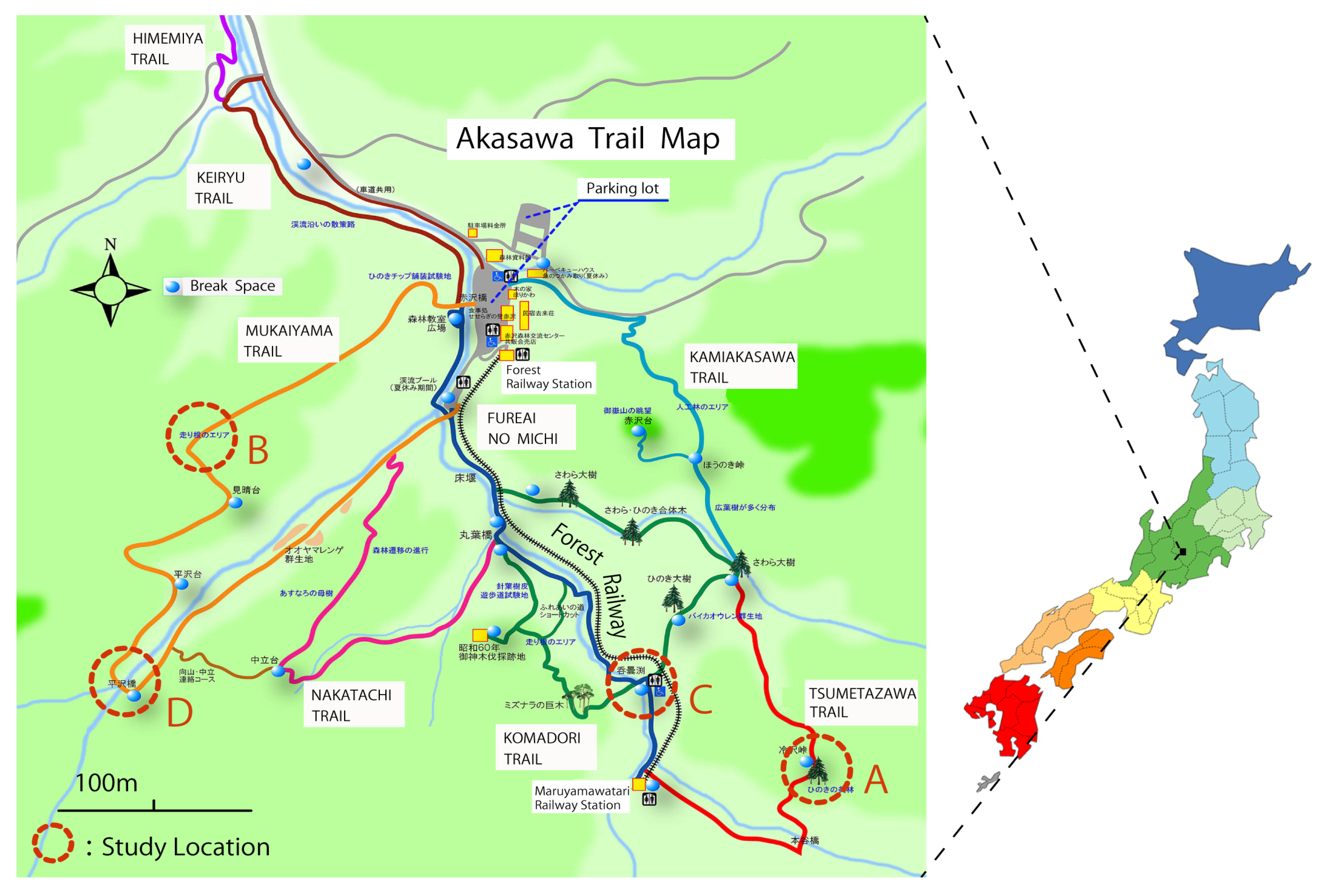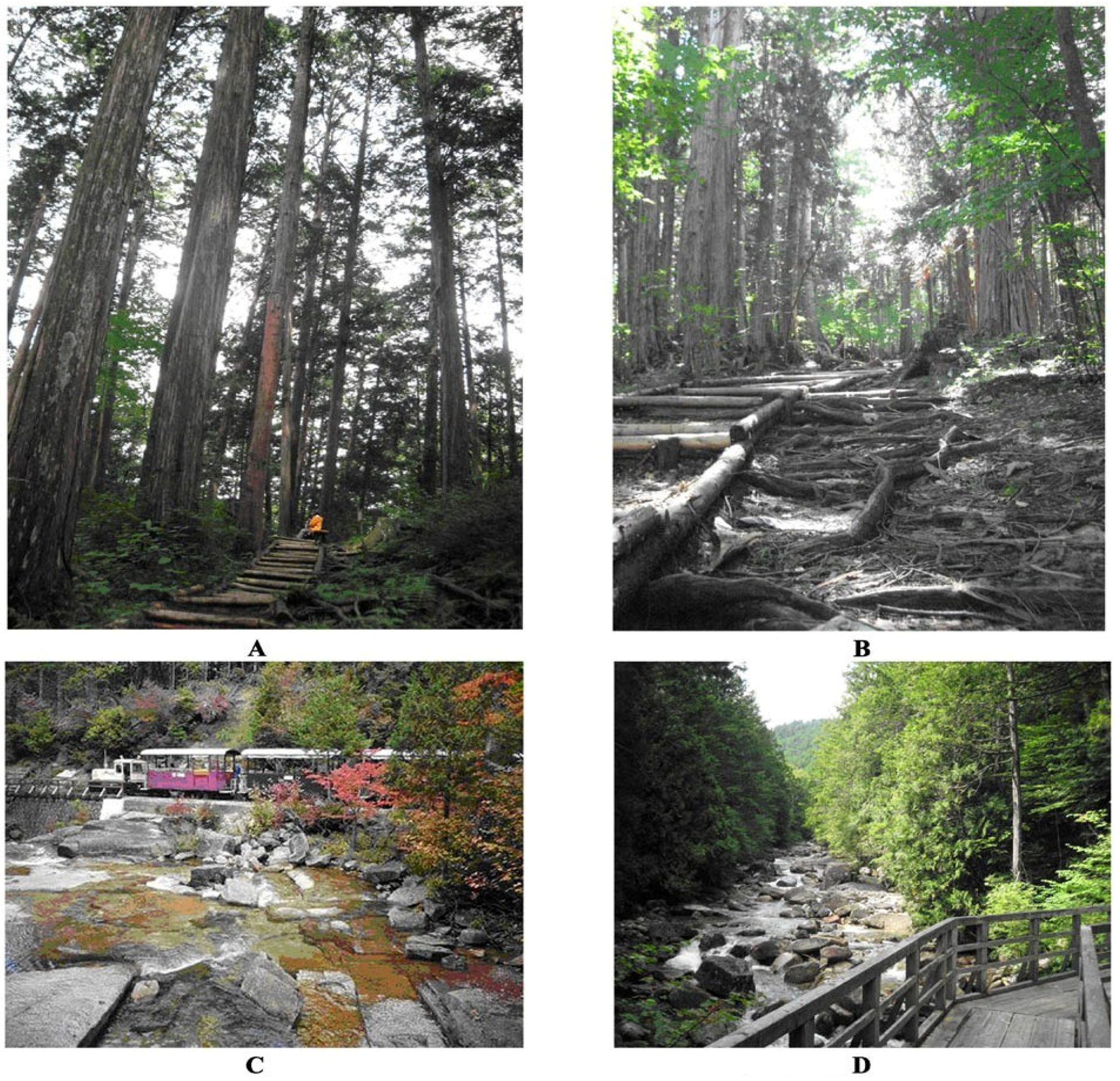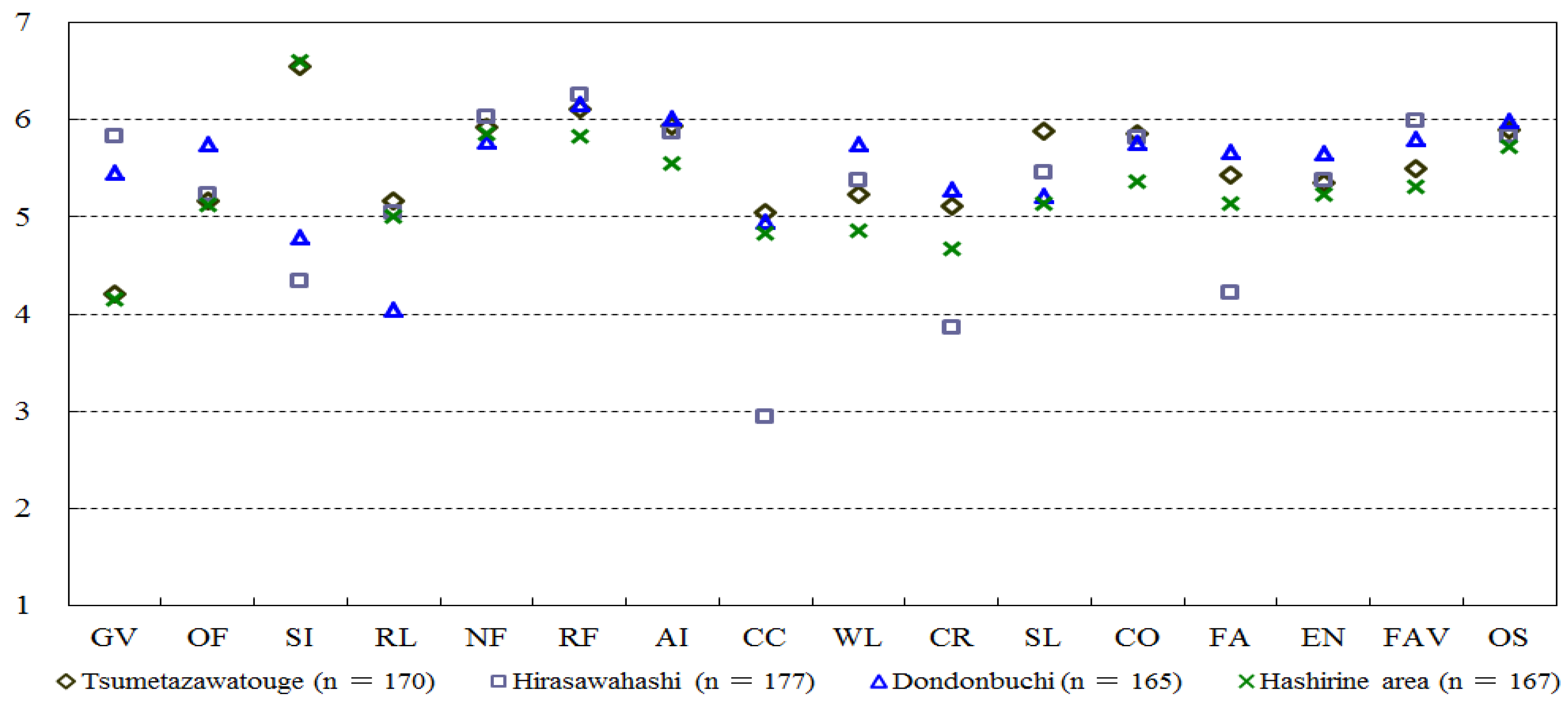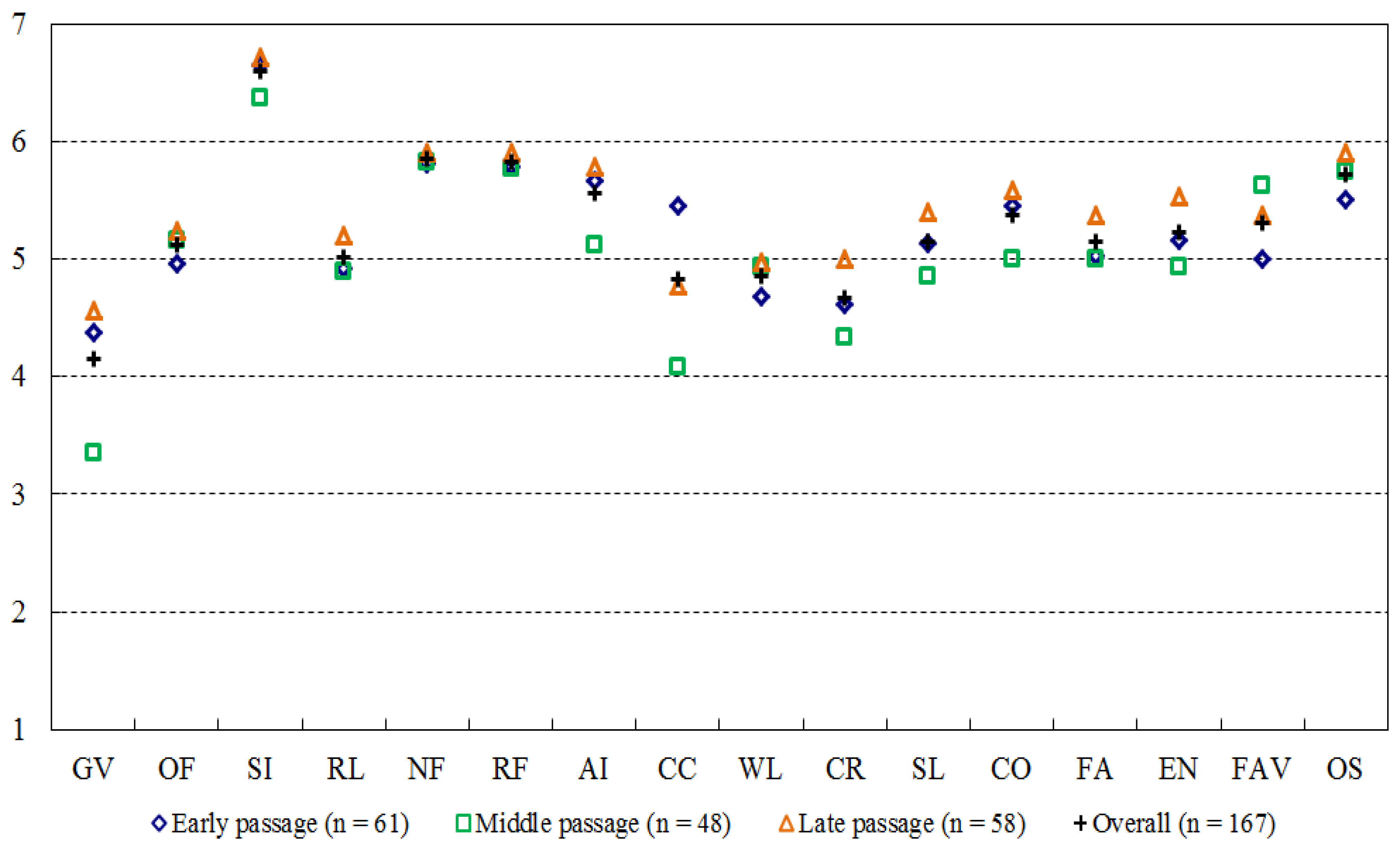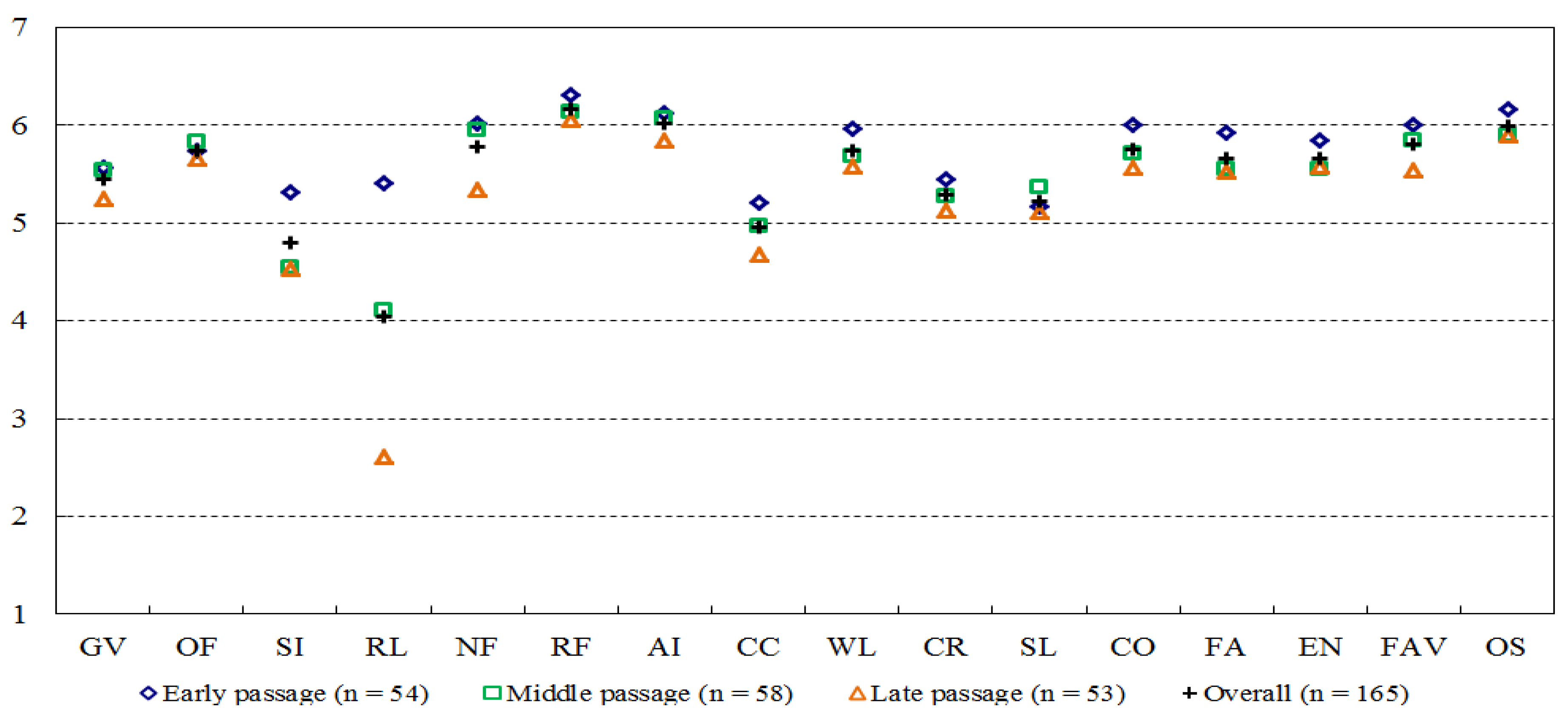1. Introduction
During the previous several decades, the leisure value of forests, e.g., the value of forests for landscape enjoyment and relaxation, has become increasingly significant [
1,
2,
3,
4] in that increasing numbers of people are enjoying forest tourism in their spare time [
5,
6,
7,
8,
9]. Previous studies have shown that the activity of walking in a forest can relieve stress caused by an individual’s work or life [
10,
11,
12]. In addition, forests contributed to patients’ recovery [
13]. For example, the convalescent period of patients who could see trees was shorter than that of patients who could not [
14]. According to the results of an investigation performed by the Japanese Cabinet Office in 2007 [
15], the top three reasons that people planned to visit a forest included “mental diversion by forest bathing” (62.1%), “to experience contact with nature” (42.4%), and “to enjoy an attractive scene” (43.2%). These results suggest that outdoor activities, such as forest bathing and walks through forests, meet a crucial social need. Therefore, provisions for walking paths and spaces where people can enjoy the forest experience are important [
16,
17,
18,
19,
20,
21].
Before planning for forest management, it is essential to understand the landscape conditions of forests, which may be performed by landscape evaluation. In earlier research, the expert-based estimation approach, which examines defined visual properties and biophysical features of a landscape using quantitative methods, has been widely applied to assess forest landscape quality [
22,
23]. However, this approach yields poor reliability due to its strong reliance on the knowledge and experiences of a few professional experts or foresters [
24]. With increasing attention being paid to forest recreation, people have become the key users of forest landscapes. Consequently, there are now several perception-based estimation approaches in which visitors are the subjects of assessment [
25,
26,
27,
28]. Daniel (2001) concluded that perception-based assessments yield greater reliability than expert-based approaches [
24].
Based on perception-based approaches, several studies applied a photograph projective technique to understand people’s perceptions of nature [
2,
3,
29,
30,
31]. These researchers typically invited students and local residents to be the evaluators. However, other authors have found that color photographs are not the ideal surrogates for real landscapes in the study of forest walking because the photographs failed to capture the entire scene. With this method, it is also difficult to evaluate changes in visitors’ perceptions along their walks. Shirafuji
et al. clarified the differences between how people evaluated images of a forest landscape and the actual location in their study [
32]. Consequently, several students were invited to visit the forests for walking evaluations [
20,
21,
33,
34,
35,
36]. Although Daniel and Boster (1976) reported that students and Catholic Church group adults were most representative of the general public [
25], several authors thought the backgrounds of the people resulted in differences in preferences [
16,
37]. To control the representativeness of assessors, several researchers began to investigate perceptions of visitors with various attributes [
7,
9,
33,
38,
39,
40].
However, most previous studies focused only on the evaluation of forest environments by location [
1,
7,
32,
33,
34,
35,
36,
38,
39]. Visitors generally walk freely throughout forests rather than stay in one place. Thus, there have been several studies of dynamic changes in walkers’ behavior during their walks. These studies looked at how people perceive the sequence of experiences within a forest environment and how those perceptions affect walking behavior [
7,
17,
18,
19,
41,
42,
43]. For example, Oku
et al. suggested that a person’s experience of a landscape is accompanied by a series of sequential changes along the trail through the woods; they define these changes using five indices including walkers’ satisfaction, desirable landscape patterns, behavioral change as identified through photography and label sampling [
18,
19]. Moreover, a few researchers reported that a “good combination of the landscape factors on the walking flow” is important (in forest space) [
17,
18,
19]. Additionally, Zhang
et al. noted walkers’ behaviors in forests and clarified, through an accompanying investigation, objects evaluated by walkers along the path and features of places where the objects were perceived [
42]. A linear sequence of experience was noted in our previous study, and there are ongoing, additional studies of favorable spaces where walkers’ behaviors are extracted from the axial distribution of time and behavior, changes in how walkers evaluate their surroundings, objects evaluated and settings where objects are likely to be observed. Based on the above results, we found that determining whether there is a difference between how people evaluate forest space from a linear perspective with space as a continuum at the beginning of a walk to a single location
versus how they evaluate their experiences after having walked a long distance has surfaced as an issue. This study sought to fill this need.
In addition, clarifying how the assessments of objects are affected by changes in perception throughout a person’s walk will help planners develop walking routes that promote positive experiences. Forest managers usually want to know not only which forest spaces visitors prefer but also what spatial arrangements of landscape components are attractive. However, there have been few studies of the preferences of people who walked different distances and experienced various elements as they approached a landscape space. Accordingly, the aim of this study was to explore the following issues: (1) how people evaluate specific landscape scenes with varying components and spatial compositions after having walked different distances; (2) which types of forest environments are appreciated by visitors with different experiences; (3) which objects are easily affected by walking distances and experiences versus parameters that elicit a similar evaluation regardless of when they appear in a person’s walk; and (4) how to construct preferable walking spaces for people’s outdoor activities based on the investigation.
4. Discussion
To improve the representativeness of the evaluators, we assessed walkers rather than use students and local residents in this research. We found that female visitors outnumbered males, which reflects the family culture of Japan. For example, most Japanese women will devote all of their attention to the home after they marry. However, they are eager to vary their monotonous lives with hiking, mountain climbing and other activities, particularly after their children have grown up. Additionally, research has suggested that females are more interested in outdoor relaxation than males in Japan [
42]. In terms of the age composition, most of the respondents were in their forties, fifties or sixties. Notably, the fraction of people older than 60 was as much as 35.3%, whereas younger people (less than 40 years old) made up only 10.9% of the participants. These results can be partly explained by the fact that Japan is an aging country. Moreover, younger Japanese need to spend most of their time working and are unwilling to venture outdoors, whereas retirees are free every day and very interested in nature. However, as previous studies indicated, forest walking can help people relieve stress [
7,
8,
9,
10,
11,
12]. Accordingly, encouraging young people to enjoy outdoor recreation has become a topic of discussion recently.
There are differences in walkers’ perceptions depending on the composition of the space observed [
7,
8,
12,
20,
39].
Figure 3 shows that the visitors enjoyed different elements at different points in the landscape. For example, it seems that the walkers preferred silent environments in the forests to the sounds of a stream. Meanwhile, they appreciated a good view in open areas and the naturalness of all of the sites. Although the respondents did not have strong feelings regarding contact with natural objects, they were unsatisfied with locations where no objects could be touched. Furthermore, the walkers liked to stop to enjoy the views of distant mountains when they approached the Hirasawahashi site, but they were unable to leisurely rest there due to the lack of seating. Consequently, planners should consider installing resting facilities near the bridge. In addition, the “Favorable” indicator, which measures the degree to which an entire landscape is appreciated, was assessed differently. When the ratings assigned to the “Favorable” category were compared, the sites with a water element were rated more “Favorable” than were the wooded sites. This result was similar to those of other researchers [
18], who described how “the view of the waterside was significantly highly evaluated compared with the view of the trail”. In other words, it is likely that trails containing a water element are preferred over walking spaces that only pass through a forest [
18,
39,
42,
53].
Evidently, there was no clear trend in the evaluations of the four locations. However, when the study sites were divided into two groups, those in the woods (Hashirine area and Tsumetazawatouge) and those with a water element (Hirasawahashi and Dondonbuchi), the two wooded spaces received similar evaluations, whereas the two water spaces received significantly different ratings on most of the parameters. These results may be interpreted in terms of the unique spatial features. For example, the two wooded locations offer near-view scenes. Both of them are enclosed and silent and have regular landscapes consisting of large trees with an organized arrangement. Certainly, the different forest structures produced by the species compositions and stem densities led to the differences in the assessments of several parameters [
3,
54,
55,
56,
57]. Conversely, the two water views have different objects appreciated by people. The visitors had a good view, enjoyed the view of a distant mountain, and listened to the stream in Hirasawahashi. Compared with the far-view landscapes, however, numerous people prefer the Dondonbuchi site, where they can make contact with water and rest by sitting on the rocks and observing the fish in the stream [
4,
17,
18,
39,
42]. The walkers thought that Dondonbuchi was an enjoyable place and would like to stop to play leisurely. As a result, most of the parameters in the categories of behavior and overall evaluation received higher ratings at this site than those at other sites. Consequently, planners should consider providing special spaces for visitors to touch natural features in a forest [
17,
18,
19,
41,
42].
The analysis of trends in respondents’ perceptions at each location and the differences in these trends (
Figure 4,
Figure 5,
Figure 6 and
Figure 7) are as follows: (1) The perceptions of respondents who had walked different distances varied. (2) According to the Steel–Dwass test results, opinions with regard to the parameters varied among walkers of each passage stage, whereas opinions regarding certain parameters did not vary among Late passage walkers. It was presumed that the evaluated items, which were typically recognized by walkers of any walking stage in a given walking space, were present. Based on the similar perceptions of walkers according to walking distance and the experience of landscape, it is likely that maintaining forest features such as their “Open feeling”, “Regular landscape”, and “Natural” feel can yield high ratings not only early in a walk but also in the middle and later stages (
Table 9). However, locations with a water element differ from the forest locations studied. There were no parameters whose ratings remained constant between these two location types. However, when places were analyzed individually, commonalities were found. Six parameters—“Good view”, “Open feeling”, “Special landscape”, “Enjoyable”, “Could touch plant, water, rock, large tree” and “Could rest leisurely” were commonly evaluated even at the end of walking in Dondonbuchi. In Hirasawahashi, five parameters—“Natural”, “Refreshing feeling”, “Airy”, “Comfortable” and “Favorable”—were typically rated highly regardless of the visitor’s walking stage. The space compositions of Dondonbuchi (where walkers can descend from a bridge and touch water and rocks with forest on both sides) and Hirasawahashi (which features a mountain stream and a distant mountain view) support these findings.
As mentioned above, the following two points are derived from the composited results of the perceptions at the four locations. First, it was presumed from the presence of common items for evaluation along two wooded trails that although the forest landscape varied, people’s perceptions of the spaces were partially stable at each walking stage; Second, because no parameters received similar ratings from walkers who observed spaces with a water element, the perception of these spaces may have changed with the characteristics of the elements present, including whether walkers could touch natural objects.
In addition, the mean ratings on the 16 parameters associated with each passage stage at each site suggested that including a few special landscapes late in a walk can help visitors maintain their favorable impressions of a forest space [
1,
7,
12,
18,
39,
42]. Moreover, in the forest landscapes, it may be particularly beneficial to create a few special spaces where walkers can touch natural objects such as specific plants and stones at the beginning of a walk rather than at the end or middle (
Figure 4 and
Figure 5). In the spaces with a water element, however, the Late and Middle passage walkers perceived a noisier environment than the early passage walkers even though both groups were in the same location (
Figure 6 and
Figure 7). In other words, if a landscape includes a rushing stream, the stream should be located in the first half rather than the latter part of a walking route. Additionally, the regular landscape feature in a water space was more difficult to recognize by those respondents who encountered the location near the end of their walk than by those who did so earlier in their walk.
Unlike previous research [
1,
7,
20,
21,
33,
34,
35,
36,
38,
39], this study did not involve subjects who were brought into a forest space and asked their perceptions. For this study, we visited locations to administer a questionnaire to walkers who were visiting the locations by their own choice. For this reason, it was impossible to control the demographics or the routes of the walkers. In the future, researchers should survey not only walkers with other attributes (such as those in a young age group) but also those who visit with different types of groups and compare the resulting data to the information presented here. Moreover, although walkers’ perceptions of the study sites were analyzed here, we did not address how the long-term experience of a walking space impacted those perceptions. This should be the subject of further research in a series of sequential spatial evaluations and forest walkers’ behavior.
5. Conclusions
This study clarified changes in walkers’ evaluations of place based on when they experience a particular location in their hike, the features evaluated and the presence or absence of differences in those perceptions of forest routes based on walking distance and views of experiences matching the behaviors of walkers. Our results are summarized as follows:
(1) Walkers’ perceptions at a given location and after having walked a given distance were not constant across the parameters under evaluation, and our results indicate that walkers’ perceptions of a place may change with the distance traveled to that location.
(2) A statistical analysis revealed that certain parameter ratings varied significantly among different passage stages at a single location, whereas other parameter ratings remained stable regardless of when a person visited in their walk. Accordingly, we must consider the effects of spatial arrangements of various landscape factors on people’s perceptions in forest planning. For example, certain items such as special landscapes should be located late on a walking route to receive a high rating, whereas greater enjoyment stems for placement of a silent space where one can touch natural objects early in a walk rather than later on a route.
(3) When similar ratings that matched the behaviors of walkers were identified at each passage stage in wooded areas, it was noted that parameters such as “Open feeling”, “Regular landscape”, and “Natural” feel were perceived similarly not only early but also in the middle and late in a walk. Conversely, it was noted that differences in spatial elements and their composition, particularly in the presence of water, led to changes in perceptions through the late stage of a walk. Based on these results, we suggest that positive walking experiences can be maintained by considering the open feeling, regularity, and natural landscape in planning walking routes. The findings also indicate that taking into account the effect of spatial features of water elements on a walking experience is very important in route planning. Our study has clarified not only which types of walking space are appreciated by visitors but also how the evaluations are affected by walking distances and experiences, which provides very useful recommendations for forest managers in the design and reconstruction of forest parks. However, as mentioned above, some issues, such as effects of walkers’ attributes on their evaluations, and how the long-term experience of a walking space impacts visitors’ perceptions, should be the subjects of further research.
